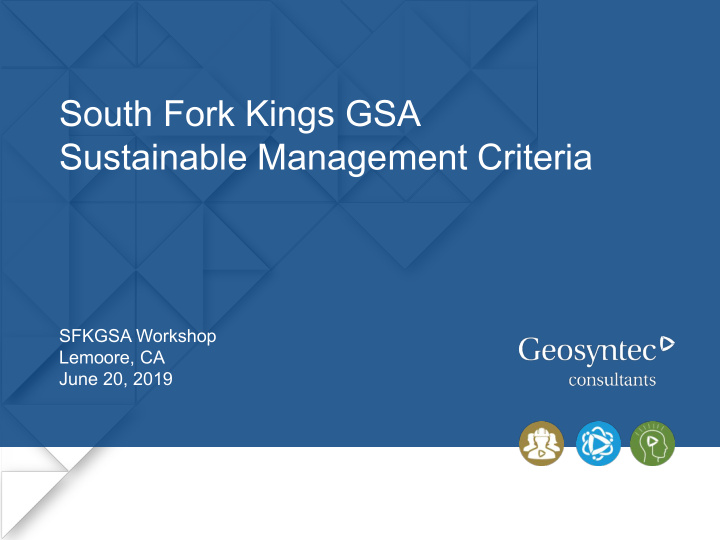



South Fork Kings GSA Sustainable Management Criteria SFKGSA Workshop Lemoore, CA June 20, 2019
TOPICS • Update on the Access Agreements for the Monitoring Network • Proposed ASR Pilot Test • Data Management System – SFK • Tulare Lake Subbasin Annual Report • Summary of GSP Chapter 4 - Sustainable Management Criteria
Access Agreements • Identified APNs and are working to identify landowners • Some cases need separate agreements with landowner and well owner • Utilize Board & TAG members to reach out to landowners • Bring each agreement to Board for approval
ASR Pilot Test • Identified a potential test well – B-zone well – Nearby surface water – Filter system • Meeting with Regulatory agencies (RWQCB, DDW, USEPA) • Prepare Workplan and obtain approvals/permits
Data Management System - SFK • On-going discussions – Where is data stored – What data will be stored – Coordinate between SFK and Tulare Lake Subbasin
Subbasin Report • Tulare Lake Subbasin Annual Report – Due April 1, 2020 – Sent requirements in 6/5 email • GW elevation contour maps • Hydrographs of GW elevations back to 2015 • GW extraction for preceding water year • Surface water supply • Total water use using best available measurement methods • Change in GW storage • Progress on Plan implementation
Summary of GSP Chapter 4 • Sustainable Management Criteria – Sustainability Goal – Water elevation to prevent undesirable results
Key Definitions • “Measurable Objective” – sustainability goal • “Minimum Threshold” – level below which unacceptable undesirable results are likely • “Representative monitoring site (RMS) Well” – representative location where sustainable management criteria are established and evaluated • “Interim RMS Well” – location in TLSB used to define sustainability goals for other similar locations while new wells are installed and additional data is collected
Sustainable Goal Analysis • Each RMS well will have unique measurable objective and minimum threshold – Linear trend (model data adjusted to current water level) – Minimum threshold = 2x standard deviation of 1998-2010 water level data • Can adjust for management actions or projects – Ex. may want to use more B-zone water, reduce C-zone use – Management goals consider water levels above clays • Sustainable groundwater management assumed after 2035 (no decline in water level trend)
Representative Monitoring Well Network A-zone RMS Well B-zone RMS Well Proposed A-zone RMS Well Proposed C-zone RMS Well B-zone Interim RMS Well (used to calculate minimum threshold) C-zone Interim RMS Well
B-zone Sustainable Management Criteria MO MT MO MT MO MT
C-zone Sustainable Management Criteria • C-zone RMS wells not installed yet • Interim RMS selected for establishing goals MO TL-SFK-13 MT Want to see higher water levels than this
SFKGSA 2040 Sustainability Goal Summary Maintain water levels at these levels or higher by 2040 Aquifer Measurable Objective Minimum Threshold (ft MSL) (ft MSL) A-zone 190 180 B-zone -5 to -60 -40 to -95 C-zone -130 -185 Aquifer Measurable Objective Minimum Threshold (ft bgs) (ft bgs) A-zone 30 20 B-zone 225 to 260 260 to 295 C-zone 330 385
Other • GW Storage – Maintain volume to provide GW for 5yr drought • Subsidence – Highest forecasted total subsidence with projects is 4 ft – Subsidence also occurring outside of Subbasin • Groundwater Quality – No impact to crop yield or beneficial uses • Interconnected Surface Water – None
Recommend
More recommend